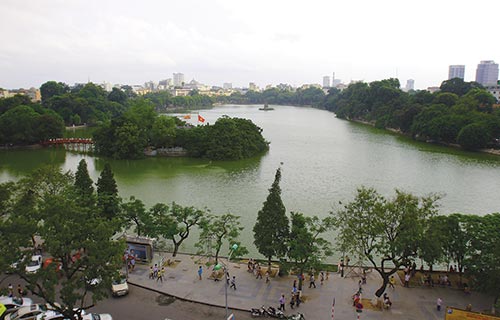
| Hanoi leads green FDI charm offensive | |
Hanoi is making great strides to attract environmentally-friendly foreign direct investment projects. In early August 2014, Hanoi issued a new post-investment interest support programme. Throughout this year, the city plans to offer a 0.2 per cent per month loan interest to medium and long-term loans of at least one year for businesses based in Hanoi who take loans for new investment projects, expand project scope or invest in equipment and technology innovations. The move aims to help city-based businesses to remove difficulties in production and training amid the slow economic recovery, said director of the Hanoi Municipal Authority for Planning and Investment Ngo Van Quy. “We are scaling up efforts to attract investment from domestic and external sources,” said Quy, adding that thanks to these efforts during 2008-2013 Hanoi had lured around VND1,141 trillion ($54.3 billion) in the total investment development capital to satisfy the city’s development needs. In fact, by end of June Hanoi was home to 2,806 on-going foreign direct investment (FDI) projects worth $21.1 billion in the total committed investment capital. Hanoi currently stands third in terms of wooing FDI. Scores of sizable FDI projects have contributed to spurring production, business and economic development in the city. Growing visibility of global players like Japan’s Panasonic and Canon in the city’s industrial parks (IPs) have made a significant contribution to the local industrial production and export development. As of June, foreign invested enterprises (FIEs) posted revenues of about $4.86 billion, up 12.3 per cent on-year. FIEs also contributed more than $2.6 billion, representing 48.6 per cent of the city’s total export value. However, city officials admit that FDI inflows could be higher. “There are multiple reasons why we’re still lagging behind expectations. That is partly because the world and local economy is still mired in hardship. In addition Hanoi’s administrative boundaries were extended in 2008, so many planning schemes still await approval, making it hard to attract investment,” Quy shared. He also said low quality investment promotion activities, a lack of long-term vision and uniformity in policies governing investment and business had attributed to Hanoi’s faring well below expectations when attracting FDI. “We may expect big turnabout in the coming period in the wake of the city’s reformed investment promotion mechanism. Detailed steps are embedded in the city’s investment promotion programme for 2014-2015 with an orientation to 2020,” Quy noted. The programme, approved by the city’s management authorities in June, seeks to promote investment on a selective basis, targeting strategic partners, key foreign markets as well as hi-tech fields with high added value. In the past years, priority has been granted to attracting big investors and projects which have knock-on effects to help lure other investors and partners to the city. “We also know that bettering the investment climate is crucial to attracting investors and there is a need to focus on facilitating project execution,” Quy added, saying that the capital demand for the city’s socio-economic development in the coming period is tremendous, so that further investment attraction was vital. “Good quality and environmentally-friendly investment sources are our priority,” Quy underscored. The Hanoi Municipal Authority for Planning and Investment’s statistics show that from 2011 to 2020, Hanoi needs to attract VND3,900-4,100 trillion ($180-190 billion) for an ambitious list of socio-economic development tasks. Some $50-55 billion has been earmarked for the period from 2012-2015 alone. The city wishes to woo up to 20 per cent of this sum from FDI. Hanoi authorities have already spent some time attempting to attract investors, including a particular focus on Japanese firms, in recent years. “Multinationals and sizable, hi-tech projects involving technology transfers will be the number-one priority,” said Quy, adding that selecting foreign partners was also part of the city’s overall socio-economic development strategy and strategy to attract FDI particularly. Hanoi’s investment promotion programme until 2020 also includes a list of eight projects the city plans to fund through FDI during the period. Four of them were included on a list of key national projects sourcing FDI until 2020, which was approved by the prime minister. “These projects have detailed requirements to attract investors, so we expect Hanoi will be more appealing to the investor community in the coming period. Capable investors would help bolster the quality and efficiency of FDI flows,” Quy affirmed. About how to realise the programme, Quy said: “Detailed tasks are assigned to particular departments, state bodies and localities. The measures cover drafting and improving policies and mechanisms to attract investment, further reforms to administrative procedures, bettering the investment climate and the city’s competitiveness ranking, improving investment promotion personnel and fostering co-operation in promoting investment between Hanoi and other locations.” In parallel to hosting investment promotion programmes at home and abroad, Hanoi will also pay due heed to spurring on-site investment through increasing support to projects which were granted investment certificates and hosting frequent dialogues with investors to settle their problems in a timely manner. “A new investment wave will arise if every stakeholder is committed and we effectively handle this ambitious investment promotion programme,” Quy underscored. | |
| VIR |
